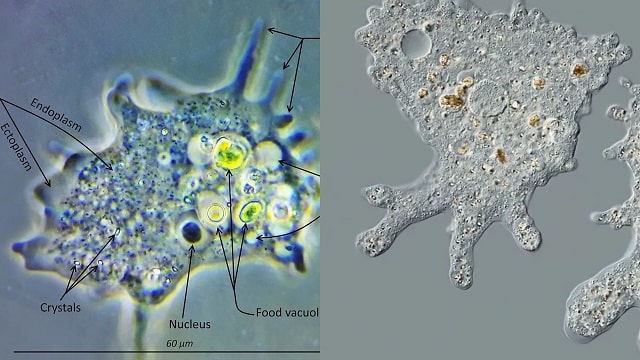What is Amoeba?
Amoeba or amoeba is a unicellular organism belonging to the protozoa group. This living creature is also included in the eukaryote category, which means it has a cell nucleus. These organisms do not have a definite body shape and can change according to needs. Amoeba generally live in freshwater environments, such as ponds and rivers. It moves using pseudopodia, a type of projection of the cell membrane, to capture food. The eating process in amoeba is called phagocytosis, which is by surrounding and absorbing food particles into its cells.
Amoeba that Causes Disease in Humans
Although most of these organisms are not harmful to human health, there are some types that can cause disease. This type of amoeba is Naegleria fowleri.
This organism can cause granulomatous amoebic disease or primary amoebic meningoencephalitis.
Naegleria fowleri has an amoeboid form that is commonly found in warm freshwater, such as swimming pools, fish ponds, and hot springs.
At human body temperature, Naegleria fowleri can transform itself into an active form that can damage brain tissue.
Infection usually occurs when water contaminated with the amoeba enters the nose and then travels to the brain.
When infected, the initial symptoms are similar to the flu. However, this condition then progresses to intense headaches, seizures, fever, vomiting, and loss of consciousness.
Amoebic meningitis can progress very quickly and has a high mortality rate.
To prevent this dangerous disease, avoid water sources that are dirty or contaminated.
Use a nose clip or nose cover when swimming in warm freshwater, and make sure the pool water is clean.
That’s the information about amoeba that you need to know.
Characteristics of Amoeba
Amoeba has special characteristics that distinguish it as a unicellular organism.
Here are some of the characteristics:
1. Flexible body
As explained earlier, this organism does not have a fixed shape because its cell walls are flexible and supple. Its body can change as needed.
This flexibility allows it to move and adapt to its surroundings.
2. Have pseudopodia (false feet)
Amoeba moves using pseudopodia, which are temporary projections from the cytoplasm that aid in movement.
Pseudopodia allow it to capture food and move in the desired direction.
These false legs allow it to prey on bacteria, algae, or other organic particles. This feeding process is called phagocytosis or pinocytosis.
3. Transparent
The body of this organism is transparent and usually looks like gelatin. Because it is transparent, you can easily see its internal structure under a microscope.
4. Has a nucleus
These organisms have a nucleus as the control center of the cell. This nucleus contains genetic material, such as DNA, which is needed for growth, development, and reproduction.
5. Can reproduce
Even though they do not have a fixed body shape, these organisms can still reproduce.
The process of reproduction of this organism is called asexual through the process of binary fission, where one cell divides into two identical daughter cells.
6. Microscopic size
Amoeba cells are very small, ranging from 250-750 microns. However, there are some species that can be seen by the human eye without the aid of tools.
7. Can turn into a cyst
Amoeba has the ability to change into a cyst form when food or environmental conditions are abnormal.
Cysts are resting forms that help these organisms survive unfavorable conditions.
Types of Amoeba
There are several types of amoeba which have different characteristics and habitats:
1. Amoeba Proteus
This type of organism is quite large in size, reaching several hundred micrometers.
Another characteristic is that it has very striking pseudopodia (false feet).
Amoeba proteus usually lives in freshwater, such as ponds and rivers.
This type of organism acts as a predator of small microorganisms, such as bacteria and other organic particles, in freshwater ecosystems.
2. Amoeba Dubia
The main characteristic of this organism is that it has serrated pseudopodia. Just like amoeba proteus, amoeba dubia is also found in freshwater environments.
This type of organism is not known to cause disease in humans.
Its existence actually has an important role in the freshwater ecosystem and helps maintain the balance of the environment.
3. Amoeba Verrucosa
This type has the characteristic of a serrated or grooved cell surface. This type of organism usually lives in fresh water, such as ponds, rivers, or lakes.
Its main role in the ecosystem is as a predator of small microorganisms and participating in the freshwater nutrient cycle.
4. Amoeba Terricola
As the name suggests, “terricola” refers to its habitat preference which is located on the ground.
These organisms contribute to the activity of microorganisms in the soil environment and play a role in the soil nutrient cycle.
Amoeba terricola acts as a predator of small microorganisms, such as bacteria and organic particles in the soil.
They help in breaking down organic matter in the soil and contribute to the soil nutrient cycle.
5. Amoeba Chaos Carolinense
There is also amoeba chaos carolinense that lives in freshwater environments. Unlike other types, amoeba chaos carolinense has a fairly large size, up to several hundred micrometers.
They also contribute to nutrient cycling and help maintain the balance of aquatic ecosystems.
6. Amoeba Hartmannella
Another type that lives in freshwater environments is the hartmannella amoeba. They usually feed on bacteria and other organic particles.
This species is also not considered a threat to human health.
Most research related to this species focuses on understanding its behavior and ecology in freshwater ecosystems.

